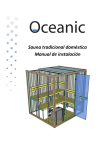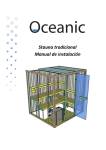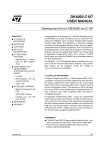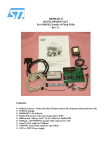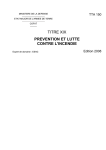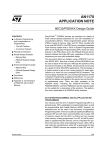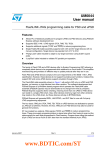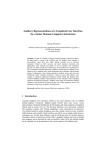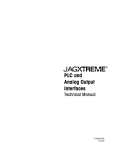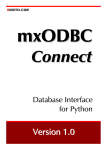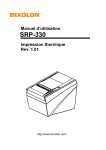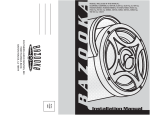Download FL_101 USER MANUAL
Transcript
FL_101 USER MANUAL FlashLink User Manual CONTENTS ■ (Introduction on next page) January 2002 1/3 FlashLink User Manual Features ❏ ❏ ❏ ❏ ❏ Overview Allows PC parallel port to communicate with PSD813F via PSDsoft Provides interface medium for JTAG communications Supports basic IEEE 1149.1 JTAG signals (TCK, TMS, TDI, TDO) Supports additional signals to enhance download speed (TERR, TSTAT) Can be used for programming and/or testing ❏ ❏ ❏ ❏ ❏ Wide power supply range of 2.7 to 5.5V Pinout independent with target side flying leads Included loopback connector to validate FlashLink and PC connection Convenient desktop packaging allows varying applications (desk, lab or production) Synchronous JTAG interface allows speeds as fast as pc can drive FlashLink is a hardware interface from a standard PC parallel port to one or more PSD813F devices located within a target pc board as shown below. This interface cable allows the PSD813F to be exercised for purposes of testing and/or programming. PSDsoft is the software source for driving FlashLink. Figure 1. FlashLink Adapter Application Flying lead cable Mates with PC parallel port 12 wires Target device FlashLink adapter 6 feet 6 inches Operating Considerations Operating power for FlashLink is derived from the target system in the range of 2.7 to 5.5V. Compatibility over this voltage range is ensured by the design of FlashLink. No settings are involved. On a cautionary note, it is recommended that the target system be powered with a well regulated and stable source of power which is energized at the final value of VCC. It is not recommended that the input voltage be varied using the verneer on a regulated power supply, as this may cause the internal FlashLink IC’s (74VHC240) to misoperate toward the lower end of the supply range. 1 FlashLink User Manual Operating Considerations Table 1. Pin Descriptions for FlashLink Adapter Assembly Signal NSignal ame Name JEN Description Description JTAG = IEEE 1149.1 JTAG =GIEEE EJTA = W1149.1 SI Enhanced JTAG EJTAG = WSI Enhanced JTAG JTAG enable on PSD813F (optional) 1 JEN TRST JTAG enable on PSD813F (optional) JTAG reset on target (optional per 1149.1) OC OC 2 JTAG reset on target (optional per 1149.1) Signal ground Signal ground Generic signal, user defined (optional) Generic signal, user defined (optional) JTAG test data input JTAG test data input OC 5 TRST GND GND CNTL CNTL TDI TDI 6 TSTAT TSTAT EJTAG programming status (optional) EJTAG programming status (optional) 7 VCC VCC VDC source from target VDC source from target 8 RST RST Target system reset (optional) Target system reset (optional) 9 TMS TMS JTAG mode select JTAG mode select 10 10 GGND ND Signaground l ground Signal 11 11 TC K TCK JTAGclock clock JTAG 12 12 GGND ND Signaground l ground Signal 14 13 TD O TDO JTAGserial seriadata l dataoutput output JTAG D estination Destination 14 14 TERR TE RR EJTAG EJTAGprogramming programmingerror erro(optional) r (optional) Destination D estination (cont.) Pin # Pin # 1 2 3 3 4 4 5 6 7 8 9 Notes Notes 1. Bold signals are required connections 1. All Bold signals areare required connections. 2. signal grounds connected together inside FlashLink 2. OC All signal 3. = open grounds collector are connected together inside FlashLink. 3. OC = open collector. 2 Type Type OC OC OC FlashLink IS SFlashLink ignal: IS Signal: Source Source Source Source Source Source Source Source Destination Destination OC OC Source Source Source Source SoSource urce FlashLink User Manual Operating Considerations Note: The target device must supply VCC to the FlashLink Adapter (2.7 to 5.5 VDC, 15mA max @ 5.5V). (cont.) Not all 14 signals may be needed for a given application. Here’s how they break down: ❏ ❏ ❏ ❏ ❏ ❏ ❏ (6) Core signals that must be connected: TDI, TDO, TMS, TCK, VCC, GND (2) Optional signals for enhanced ISP: TSTAT, TERR (1) Optional signal to control multiplexing of the JTAG signals: JEN (1) Optional IEEE-1149.1 signal for JTAG chain reset: TRST (1) Optional signal to allow FlashLink to reset target system after ISP: RST (1)* Optional generic control signal to target system from FlashLink: CNTL (2) Two additional ground lines to help reduce EMI if a ribbon cable is used. These ground lines “sandwich” the TCK signal in the ribbon cable. * = Not supported initially by PSDsoft Target Side Pinouts There is no indsutry “standard” JTAG connector. Each manufacturer differs. ST has a specific connector and pinout for the FlashLink programmer adapter. The connector scheme on the FlashLink adapter can accept a standard 14 pin ribbon connector (2 rows of 7 pins on 0.1" centers, standard keying) or any other user specific connector that can slide onto 0.025" square posts. The pinout for the FlashLink adapter connector is shown in Figure 2. If a standard ribbon cable is used for quick connection of the FlashLink adapter to the target circuit card assembly, then the target system should use the pinout as shown in Figure 2. Figure 2. JTAG Connector Recommended Pinouts ST ENHANCED JTAG ISP CONNECTOR DEFINITION 14 13 TERR TDO 12 GND 11 TCK 10 GND 9 8 RST Connector reference: Molex 70247-1401 TMS 7 VCC 5 6 TSTAT TDI 3 4 CNTL GND 2 TRST VIEW: LOOKING INTO FACE OF SHROUDED MALE CONNECTOR. 0.025" POSTS ON 0.1" CENTERS. 1 JEN KEY WAY Recommended ribbon cable for quick connection of FlashLink adapter to end product: Samtec: HCSD-07-D-06.00-01-S-N Digikey: M3CCK-14065-ND Note: TDI is a signal source on the Flashlink and should be a signal destination on the target board 3 1 1 PA D1 S1 PA D1 S2 PA D1 4 S HIELD (DRAIN WIRE) (FRAME GND) SOLDERI NG PAD PATTERN CBL 1 D0(TCK ) DB2 1 D1(TMS) DB3 2 D2(TDI) DB4 3 D3(J EN\) DB5 4 D4(TRS T)DB6 5 D5(RS T) DB7 6 G ND DB1 8 7 A CK N DB1 0 8 PA P DB1 2 9 ERRN DB1 5 10 S EL DB1 3 11 B US Y DB1 1 12 D6 DB8 13 A UTO LINE FEEDDB1 4 14 0 R80 V CC grey black orgt brnt white red org pink yellow green lt gree n 4 1 48 D3 4 1 48 D2 47 R41 4 .7 K 10K R40 2 47 47 47 47 R10 R25 R11 R9 4 7 0K 47 R7 R5 47 47 R3 47 47 R1 47 Figure 3. FlashLink Schematic FlashLink User Manual 3 1 V CC Q1 2 N3 9 0 4 R8 R6 R4 R2 10K R26 13 13 11 C53 2 C54 10 12 7 4 A C05 12 7 4 A C05 U3F R28 4 .7 K 1 UF C50 D1 6 .2 V U3D 2 6 10K 10K 10K 10K 0 .0 1 UF C51 V CC 9 3 U3C 1 0 0K R51 R38 R37 R36 R35 U3E V CC 7 4 A C05 10 7 4 A C05 6 9 4 5 11 Y4 Y3 Y2 Y1 8 7 4 V HC2 4 0 G A4 A3 A2 A1 U1B R33 R32 R31 C26 R30 R23 R22 (FOR U3) 0 .0 1 UF 1 0 0K 1 0 0K 1 0 0K 10K 10K 10K 3 5 7 9 V CC (FOR U1) C24 7 4 A C05 U2D 19 17 15 13 11 0 .0 1 UF 7 4 A C05 4 V CC 7 4 A C05 3 10K R39 7 4 A C05 U2B U2A 18 16 14 12 7 4 A C05 U3B U2C 1 R42 4 .7 K 7 4 A C05 8 5 Y1 Y2 Y3 Y4 7 4 V HC2 4 0 G A1 A2 A3 A4 U1A C25 R43 4 .7 K C55 1 2 4 6 8 (FOR U2) 0 .0 1 UF R29 4 .7 K C58 7 4 A C05 C57 7 4 A C05 U2F U2E U3A C56 1 V CC C52 1 0 0p f 1 0 0p f 1 0 0p f 1 0 0p f 1 0 0p f 1 0 0p f 1 0 0p f V CC R50 R16 47 47 47 47 47 R20 R18 47 R34 1 0 0K R19 R17 R15 R13 D4 Th ur s d a y , A p ril 0 8, 1 9 99 Dat e : 0 1 N5 8 1 7 Doc u me n t Nu m be r Fla s h L in k PCB Fla s h L in k S c h em a tic R21 S iz e B Title 4 7 28 0 K a to Ro a d Fre mo n t, CA 9 45 3 8 W a fe rs c ale In te g r a tio n 10 47 R14 47 47 R12 47 R81 S he e t 1 CO NTROL TDI TSTA TN V CCIN RSTN TMS G ND TCK G ND TDO TERRN /JEN TRS TN of 1 7 0 24 7 - 1 4 0 1 MO L EX 1 2 3 4 5 6 7 8 9 10 11 12 13 14 P1 Rev G1 4 FlashLink User Manual Operating Considerations A schematic of FlashLink is shown on the previous page. (cont.) Note: This equipment has been tested and found to comply with the limits for a Class A digital device, pursuant to Part 15 of the FCC Rules. These limits are designed to provide reasonable protection against harmful interference when the equipment is operated in a commercial environment. This equipment generates, uses, and can radiate radio frequency energy and, if not installed and used in accordance with the instruction manual, may cause harmful interference to radio communications. Operation of this equipment in a residential area is likely to cause harmful interference in which case the user will be required to correct the interference at his own expense. For further information, see the PSDsoft Users Manual. Figure 4. Chaining Example FlashLink Target System, 3V or 5V 7 7 9 TMS 11 TCK TDI 5 9 VCC 6 TSTAT 14 TERR 13 TDO JEN 1 TRST 2 GND* 3 CNTL 4 RST 8 GND* 10 GND* 12 11 5 optional optional 6 14 13 VCC 10K typical 1 TMS TCK TDI TDO TSTAT TERR PSD813Fx optional optional optional optional optional 2 TMS TCK 12 straight through cable 2 row, 7 position TDI TDO TSTAT TERR PSD813Fx JTAG Chaining example on target system using straight through ribbon cable * all ground pins are connected together inside flashlink assembly 5 FlashLink User Manual Operating Considerations Figure 5. Loopback Adaptor (cont.) J1 To FlashLink Assembly 1 2 3 4 5 6 7 8 9 10 11 12 13 14 J2 GND 1 TDI TSTAT VCC J1 GND CON2 1 VCC CON1 TMS TCK TDO TERR CON14 14-pin Dual Row 0.025 square Receptacle Output Signal Signal PC Parallel Port Connector Line (DB25 Pin No.) JEN STAT SEL (11) TDI TSTAT ACKN (8) TMS TERR ERRN (10) TCK TDO PAP (9) 6 FL_101 - USER MANUAL Table 1. Document Revision History Date 30-Jan-2002 2/3 Rev. Description of Revision 1.0 Document written in the WSI format 1.1 FL_101: FlashLink User Manual Front page, and back two pages, in ST format, added to the PDF file Any references to Waferscale, WSI, EasyFLASH and PSDsoft 2000 updated to ST, ST, Flash+PSD and PSDsoft Express FL_101 - USER MANUAL For current information on PSD products, please consult our pages on the world wide web: www.st.com/psm If you have any questions or suggestions concerning the matters raised in this document, please send them to the following electronic mail addresses: [email protected] [email protected] (for application support) (for general enquiries) Please remember to include your name, company, location, telephone number and fax number. Information furnished is believed to be accurate and reliable. However, STMicroelectronics assumes no responsibility for the consequences of use of such information nor for any infringement of patents or other rights of third parties which may result from its use. No license is granted by implication or otherwise under any patent or patent rights of STMicroelectronics. Specifications mentioned in this publication are subject to change without notice. This publication supersedes and replaces all information previously supplied. STMicroelectronics products are not authorized for use as critical components in life support devices or systems without express written approval of STMicroelectronics. The ST logo is registered trademark of STMicroelectronics All other names are the property of their respective owners © 2002 STMicroelectronics - All Rights Reserved STMicroelectronics group of companies Australia - Brazil - Canada - China - Finland - France - Germany - Hong Kong India - Israel - Italy - Japan - Malaysia - Malta - Morocco - Singapore - Spain - Sweden - Switzerland - United Kingdom - United States. www.st.com 3/3









